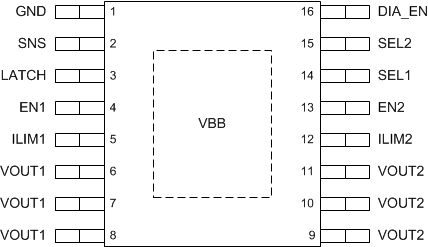SLVSDZ5A February 2018 – January 2020 TPS2HB50-Q1
PRODUCTION DATA.
- 1 Features
- 2 Applications
- 3 Description
- 4 Revision History
- 5 Device Comparison Table
- 6 Pin Configuration and Functions
- 7 Specifications
- 8 Parameter Measurement Information
-
9 Detailed Description
- 9.1 Overview
- 9.2 Functional Block Diagram
- 9.3
Feature Description
- 9.3.1 Protection Mechanisms
- 9.3.2 Diagnostic Mechanisms
- 9.4 Device Functional Modes
- 10Application and Implementation
- 11Power Supply Recommendations
- 12Layout
- 13Device and Documentation Support
- 14Mechanical, Packaging, and Orderable Information
Package Options
Mechanical Data (Package|Pins)
- PWP|16
Thermal pad, mechanical data (Package|Pins)
Orderable Information
6 Pin Configuration and Functions
PWP Package
16-Pin HTSSOP
Top View

Pin Functions
| PIN | I/O | DESCRIPTION | |
|---|---|---|---|
| NO. | NAME | ||
| 1 | GND | — | Device ground |
| 2 | SNS | O | Sense output |
| 3 | LATCH | I | Sets fault handling behavior (latched or auto-retry) |
| 4 | EN1 | I | Channel 1 control input, active high |
| 5 | ILIM1 | O | Connect pull-up resistor to VBB to set current-limit threshold on CH1 |
| 6-8 | VOUT1 | O | Channel 1 output |
| 9-11 | VOUT2 | O | Channel 2 output |
| 12 | ILIM2 | O | Connect pull-up resistor to VBB to set current-limit threshold on CH2 |
| 13 | EN2 | I | Channel 2 control input, active high |
| 14 | SEL1 | I | Diagnostics select 1 |
| 15 | SEL2 | I | Diagnostics select 2 |
| 16 | DIA_EN | I | Diagnostic enable, active high |
| Exposed pad | VBB | I | Power supply input |